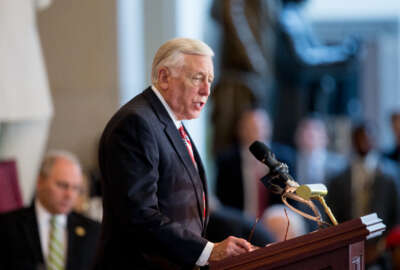

For too long, the budget and appropriations process hampered agencies and their ability to buy and modernize legacy IT systems, Federal CIO Tony Scott said. The...
Now is the time for Congress to step in and help agencies buy more modern IT rather than continuing to throw “easy money” at outdated legacy systems, said federal Chief Information Officer Tony Scott.
But Scott said he’s optimistic, as the Office of Management and Budget pushes its new legislative proposal for a $3.1 billion revolving IT Modernization Fund on Capitol Hill.
“They’ve been very inviting so far, and we have a number of things scheduled,” he said during an ACT-IAC forum on the Federal IT Acquisition Reform Act in Washington April 13. “I expect there will be a good dialogue. So far I haven’t found that this is a partisan issue at all, which is great news. The thing that struck me the most is that everybody realizes this is a pretty big problem and a pretty important thing for us to go get. So the conversations have been more around, why would this work better than some other ideas.”
Scott compared the current state of IT to a $50 car he had during college: he spent more money patching bald tires and replacing failing brake systems every month than he would have on repairs for a new car. But he didn’t have the money to buy a different one, and his friends only contributed to the problems when they borrowed his car.
“The easiest money to get is money to hold on to the old systems and keep patching and plugging and repairing the old stuff,” Scott said. “The hardest money to get is the money to replace it.”
“CIOs and agencies are in that same predicament,” he added. “Every year, we get new laws passed and new things added to our mission, and we’re piling all that stuff on old technology. That costs money to do, too. What’s leftover after you keep the [systems] running and all the stuff you have to do to run your mission? There’s very little left for you to go replace or upgrade critical applications and infrastructure.”
OMB submitted its legislative proposal for the fund to Congress last week, as House Minority Whip Steny Hoyer (D-Md.) introduced a bill Monday that would put the White House’s plan into reality.
Scott said he expects details in the proposal will change as it goes through the “usual kneading and shaping” of the legislative process.
“Other good ideas will come in as well,” he said. “I wouldn’t be standing up here to tell you I think this is exactly how this is going to turn out in the end. What’s more important to me is that we focus on the principle, on the notion of what it is we’re trying to do.”
But he insists that having agencies pay back the funds they use through earned savings is a necessary part of OMB’s proposal.
“When leadership has to pay for something over time, they pay attention to it,” Scott said. “They make sure that it’s going to go well. They make sure that there’s the right leadership in place. They make sure that the right business decisions get made. This is something they have to live with for a while. You take care of it better.”
Scott said the key to agencies’ success will be in the required business cases they must present when applying to be part of the revolving fund. OMB is asking agencies to begin some of the up-front planning now, regardless of whether the administration’s $3.1 billion fund gets a stamp of approval from Congress.
OMB is telling agencies to look at their high-value assets and begin making decisions now about the legacy systems they want to replace or modernize. It’s a similar effort agencies began during the 30-day cybersecurity sprint, Scott said.
Planning now will also help the administration determine what kind of demand it might receive for modernization funding. Scott said OMB has an idea what the response from agencies will be, but it’s still unclear what major systems have the most dire needs.
“We need to know how bad is it?” he said. “When do we have to fix it? How much is it going to cost and what are we going to replace it with? What I hope we can do at the end of the day is get a new motion going, and this new motion would be one that looks like, sounds like, walks like and talks like continuous upgrade and replacement.”
The budget and appropriations process also made it too easy for agencies to hide behind their outdated legacy IT systems, Scott said. The development of the modernization fund, in addition to new responsibilities under the Federal IT Acquisition Reform Act, will change that.
“It’s going to require changes in the way agencies do budgeting,” he said. “It’s going to require changes in the way we buy things. It’s going to make changes in the way we govern and the conversations we have with all of our partners, both within the government and outside government.”
Scott said he expects the skill sets of some chief information officers will change during the next administration, as FITARA puts more responsibility on CIOs.
“We have some CIOs who are, quite frankly, used to hiding a little bit and doing their thing,” he said. “This requires them to be a little more out there and engaging and rubbing shoulders with their counterparts.”
Copyright © 2025 Federal News Network. All rights reserved. This website is not intended for users located within the European Economic Area.
Nicole Ogrysko is a reporter for Federal News Network focusing on the federal workforce and federal pay and benefits.
Follow @nogryskoWFED

